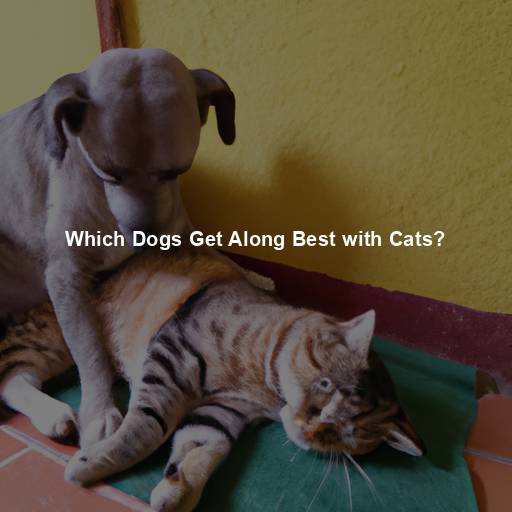What Dogs Really Think About Cats
Last Updated on July 18, 2023 by Evan
Contents [hide]
Gradual s
When introducing a dog and a cat for the first time, it is vital to proceed slowly and gradually. Start by allowing them to sniff each other’s scent through a closed door or a barrier. This helps familiarize them with each other’s presence without direct contact. Over time, you can progress to supervised face-to-face introductions in a controlled environment.
Positive Reinforcement
Reward-based training is a powerful tool in shaping positive behavior and associations. Whenever the dog and cat interact calmly and positively, reward them with treats, praise, or playtime. This reinforces their good behavior and helps them associate each other’s presence with pleasant experiences. Consistency is key, so ensure that both animals receive rewards whenever they display desirable behavior in each other’s company.
Provide Separate Resources
To avoid potential conflicts, ensure that both the dog and cat have their own separate resources, such as food bowls, water bowls, litter boxes, and resting areas. This helps prevent competition and allows each animal to feel safe and secure in their own spaces. Providing vertical spaces, such as cat trees or shelves, can also give cats an escape route where they can observe the dog from a safe distance.
Supervision and Safety
During the initial stages of their relationship, it is crucial to supervise interactions between dogs and cats. This allows you to intervene if any signs of fear, aggression, or discomfort arise. Use positive reinforcement to redirect their attention towards positive behaviors and distractions. Additionally, ensure that both animals are up to date on their vaccinations and parasite control to maintain their overall health and well-being.
Encourage Play and Bonding
Discover the magical realm where dogs and cats harmoniously unite through the enchanting power of playtime. Unleash their wild spirits with interactive toys that effortlessly bridge the gap between these majestic creatures, balancing excitement and safety. As their paws dance gracefully in the air, observe their unique play styles intertwine, and witness an extraordinary friendship blossoming before your eyes. Let the bond between these furry companions thrive as they embark on a captivating journey of camaraderie and endless amusement.
Celebrating Canine-Feline Friendship
Creating a profound connection between our canine and feline companions demands an open mind, an abundance of empathy, and a dash of flexibility. As we embark on this adventure, we must brace ourselves for the unexpected hurdles that may present themselves. Yet, in the face of these trials, the potential for an unbreakable bond between these diverse species is boundless, leaving us in awe of the magic that can blossom from such an unlikely alliance.
In our quest as adoring companions of our beloved furry friends, we bear the weighty obligation of crafting an immersive realm where the noble species of canines and felines can not merely coexist, but flourish in harmonious accord. It is through our embrace of their boundless idiosyncrasies, our zealous advocacy for constructive interactions, and our unwavering commitment to the sanctity of personal boundaries that we unlock the treasure trove of canine-feline camaraderie. Within this idyllic sanctuary, our hearts shall resound with the symphony of wagging tails and melodic purrs, heralding the triumph of untainted affection and the perennial splendor of a household steeped in love and felicity.
FAQs – What Dogs Like Cats
Does every dog get along with cats?
Not every dog gets along with cats. Just like humans, dogs have different personalities and preferences. Some dogs may have a natural instinct to chase or be aggressive towards cats, while others may be more tolerant or even friendly. It is important to carefully introduce dogs and cats to each other and monitor their interactions to ensure they can live harmoniously together.
How can I introduce my dog to a cat?
When introducing a dog to a cat, it is crucial to take the process slowly and gradually. Start by keeping them in separate rooms, allowing them to get used to each other’s scent. Then, you can have controlled, supervised meetings between them, preferably with the dog on a leash. Reward positive behavior from both pets and provide them with treats to associate each other’s presence with something positive. Always closely monitor their interactions and be prepared to intervene if any signs of aggression or stress arise.
Are certain dog breeds more likely to get along with cats?
While breed stereotypes exist, they do not always hold true for individual dogs. However, some dog breeds tend to have a better reputation for being cat-friendly due to their gentle demeanor and low prey drive. These breeds may include Golden Retrievers, Labradors, Beagles, Basset Hounds, and Cavalier King Charles Spaniels. Remember, each dog is unique and should be evaluated individually for their compatibility with cats.
Can I train my dog to like cats?
It is possible to train a dog to be more tolerant of cats, but it requires time, patience, and consistent positive reinforcement. Use treats and praise to reward your dog for calm and friendly behavior towards cats. Gradually expose them to cats in controlled environments, gradually increasing the level of interaction as they become more comfortable. Professional dog trainers or behaviorists can also provide guidance and help tailor a training plan specifically for your dog’s needs.
How can I ensure a peaceful coexistence between my dog and cat?
Creating a harmonious living environment for your furry friends, those rambunctious canines and feline divas, can be a perplexing puzzle to solve. Enter the game changer – providing separate spaces and resources for each of your beloved pets. From their own royal feeding areas to majestic beds and litter boxes, give them a taste of exclusivity. It’s crucial to lavish both pets with undivided attention and ample playtime, quelling any hint of jealousy or rivalry. It’s a fine dance of supervision and gradual integration, ultimately forging a bond of mutual understanding. And don’t forget the key ingredients – consistency, training, and socialization – vital elements in this grand adventure of fostering a harmonious coexistence.
What should I do if my dog and cat don’t get along?
Are your furry friends constantly at odds, no matter how hard you try to mend their relationship? It’s time to wave the white flag and call in the experts! Veterinarians, dog trainers, and animal behaviorists can unravel the mysterious enigma of their volatile dynamic. Brace yourself for personalized guidance tailored to your specific situation, as they unlock the secrets to fostering harmony and curbing hostility. In extreme cases, you might even ponder the thought of separate dwellings for your beloved pets to ensure their safety and contentment.







